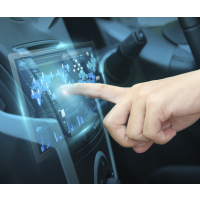Computers are Drivers, Says NHTSA in Boost to Self-Driving Auto Industry
 (photo: Getty Images)
(photo: Getty Images)
By Tom Krisher and Justin Pritchard, Associated Press
DETROIT (AP) — Computers that control cars of the future can be considered drivers just like humans, the federal government's highway safety agency has decided.
The redefinition of "driver" by the National Highway Traffic Safety Administration is an important break for Google, which is developing self-driving cars that get around without steering wheels, pedals — or even the need for a person to be inside.
Though treating a computer like a driver for regulatory purposes helps Google, its cars have miles to go before they get on the road in great numbers. While the safety agency agreed with Google's "driver" reinterpretation in a recent letter, it didn't allow other concessions and said numerous federal rules would have to be changed to permit the cars.
Google, a subsidiary of Alphabet Inc., is testing dozens of prototypes in California, Texas and Washington. The company has suggested they could be ready for the public in a few years.
In written requests over the past three months, Google asked the safety agency to interpret federal code in ways that would ease the path to market for its cars.
The agency agreed that the car can be a driver but, in a Feb. 4 response posted on its website, also rejected the company's claim that the cars comply with many related regulations including requirements for foot or hand brakes. Google said the requirement wasn't necessary because the electronic driver can stop the cars. The government said regulations are clear and would have to be changed to allow that.
"In a number of instances, it may be possible for Google to show that certain (federal) standards are unnecessary for a particular vehicle design," Paul Hemmersbaugh, the highway traffic safety agency's chief counsel, wrote. "To date, however, Google has not made such a showing."
To put their cars on the road, automakers must self-certify that they meet federal safety standards and get approval from the traffic safety agency. Hemmersbaugh's letter encouraged Google to apply for exemptions to the standards. It also said for some requests, the agency will have to go through the cumbersome federal rule-making process to approve the cars.
Adding a note of skepticism for Google's design, in which human control would be limited to a start and stop button, Hemmersbaugh wrote the company, might "wish to reconsider its view that a pedal may never be needed in any circumstance, and that there is not a risk of harm associated with a pedal's absence."
Google spokesman Johnny Luu said the company had no comment beyond that it was reviewing the agency's response.
After several years of caution, federal regulators said last month that they wanted to help speed the widespread adoption of self-driving cars if they prove to be safe.
In January at the Detroit auto show, Transportation Secretary Anthony Foxx said his department wants to get self-driving cars on the road quickly and will fast-track policies and possibly even waive regulations to do it.
Self-driving vehicles could eventually cut traffic deaths, decrease highway congestion and improve the environment, Foxx said. He encouraged automakers to come to the government with ideas about how to speed their development.
He also said the safety agency, which is part of his department, will oversee development of guidance for automakers on what's expected of self-driving car prototypes and what sort of tests should be used to make sure they are safe.
That policy could eventually lead to consistent national regulations for autonomous cars. Right now, individual states like California, Florida and Nevada have their own regulations.
Safety advocates worry the agency is getting too cozy with the auto industry when it comes to technology regulations.
On Wednesday, Foxx called the government's reinterpretation of driver "significant," but added in a written statement that "the burden remains on self-driving car manufacturers to prove that their vehicles meet rigorous federal safety standards."
The federal government isn't predicting when autonomous cars will be on public roads in big numbers, but some automakers have said they could be in use in limited areas by 2020 — and Google has been more bullish than that.
To Learn More:
Google Unhappy with DMV for Requiring a Driver in Driverless-Car Regs (by Ken Broder, AllGov California)
Human Drivers Create Headaches for Law-Abiding Driverless Cars (by Noel Brinkerhoff and Steve Straehley, AllGov)
DMV Puts Google Car Drivers Back Behind the Steering Wheel (by Ken Broder, AllGov California)
- Top Stories
- Unusual News
- Where is the Money Going?
- Controversies
- U.S. and the World
- Appointments and Resignations
- Latest News
- Musk and Trump Fire Members of Congress
- Trump Calls for Violent Street Demonstrations Against Himself
- Trump Changes Name of Republican Party
- The 2024 Election By the Numbers
- Bashar al-Assad—The Fall of a Rabid AntiSemite






Comments